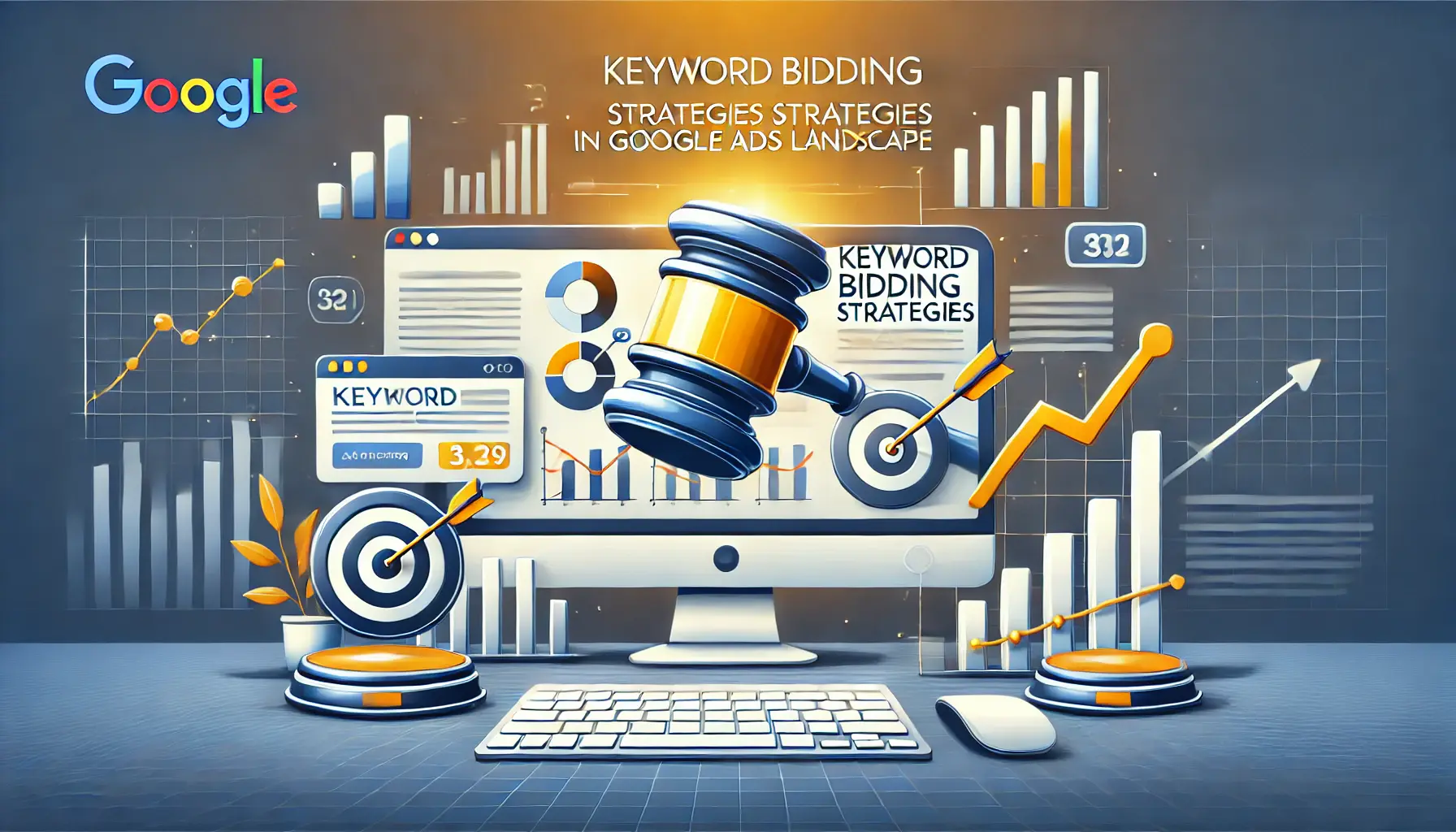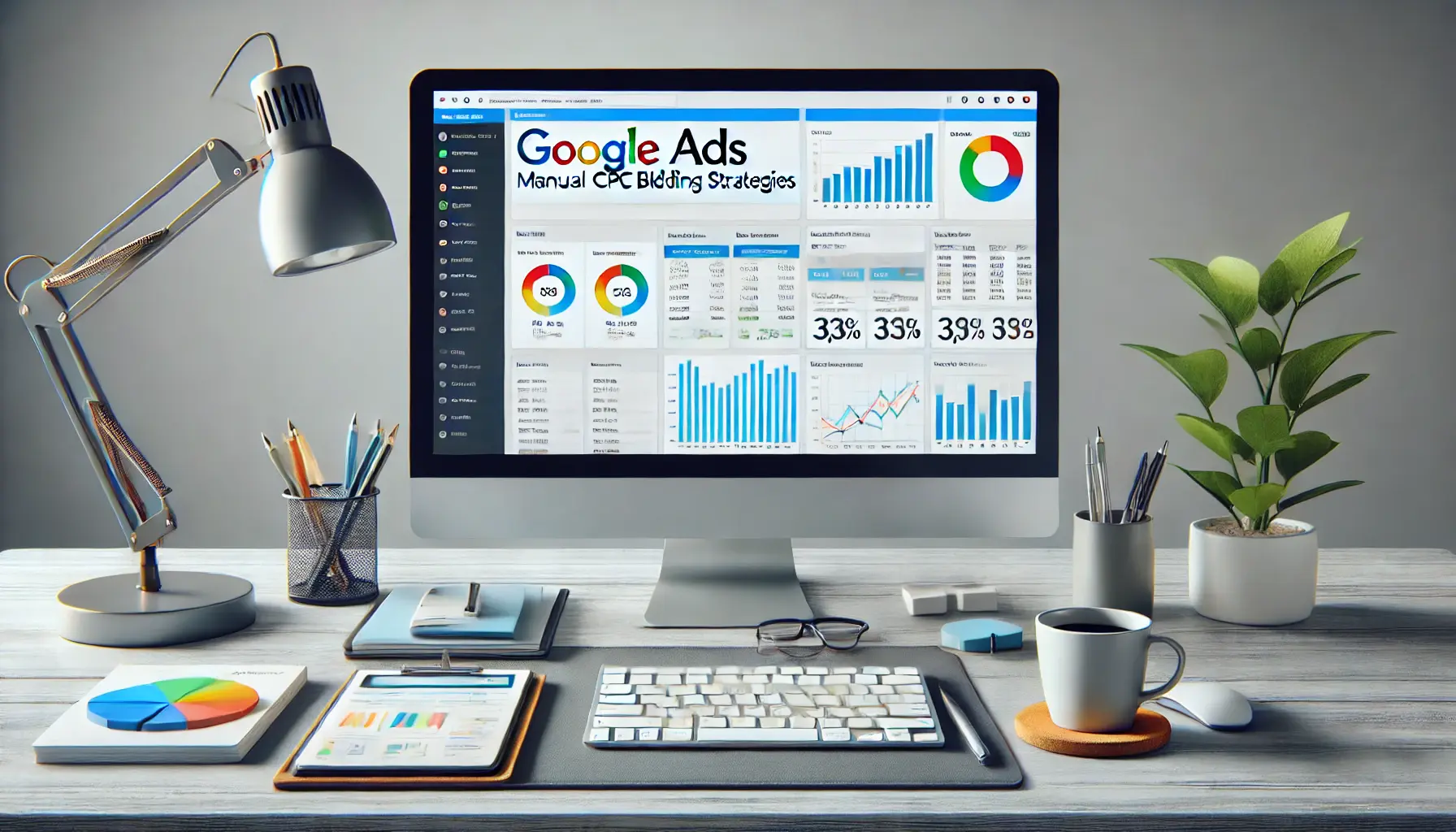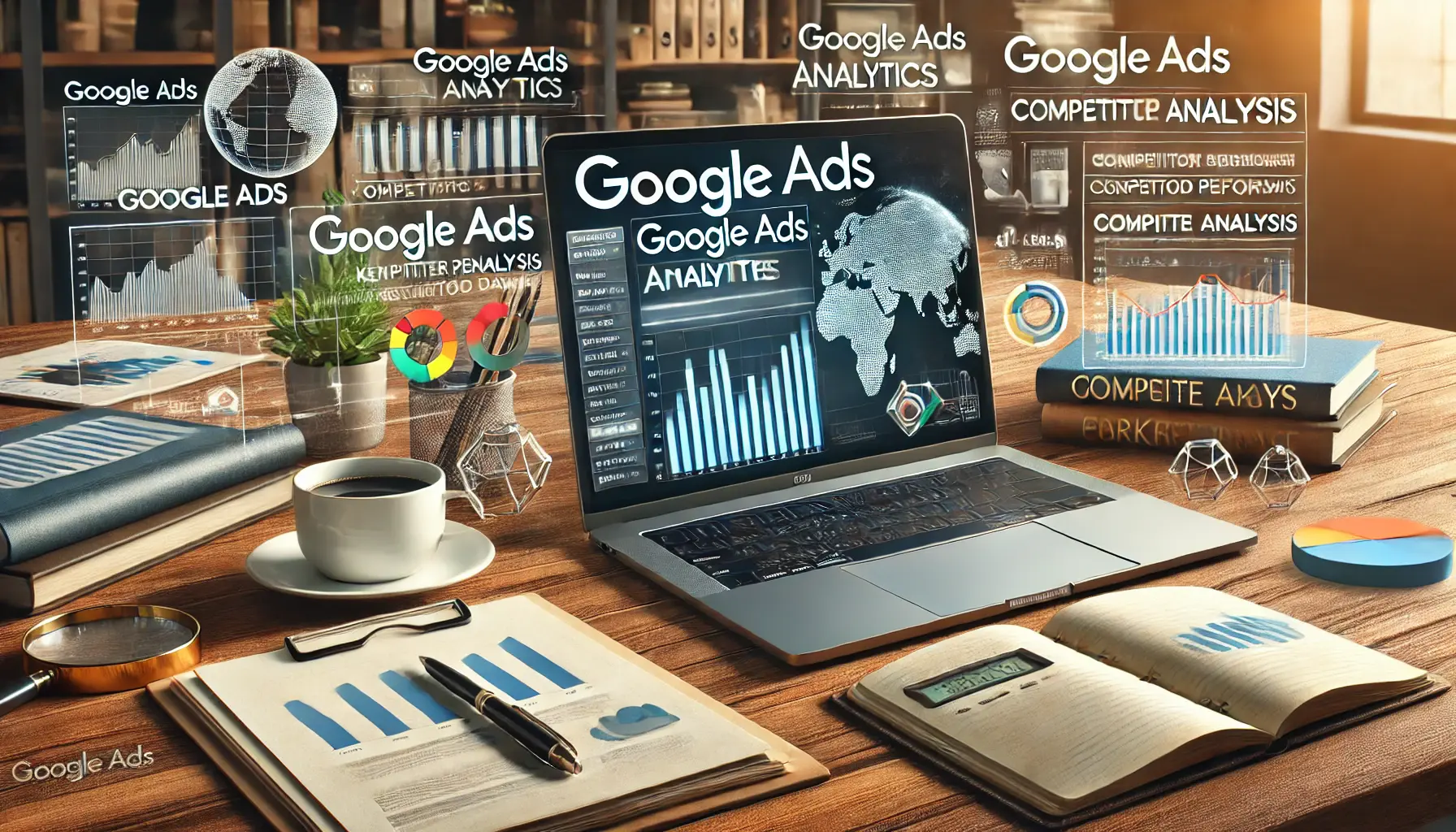Without thorough knowledge of the ins and outs of Google Ads, there is no way one can get ahead in this digital marketing world.
Among all the factors bringing about success for a campaign, keyword bidding strategies are among the most important to make good of.
The real deal here is not just the choosing of the right keywords but how much you want to pay for those keywords to come up in front of your target audience.
By selecting proper keyword bidding strategies, you will ensure maximum views for your ad, improve your return on investment, and, in this way, reach your marketing objectives.
In this article, we will walk you through some keyword bidding strategies on Google Ads and prepare you with the necessary knowledge to run effective campaigns.
One thing to keep in mind: Keyword bidding is something that cannot be mastered overnight.
The more you know about how Google Ads handles bidding, the better control you will have over the performance of your ad.
Let us break it down and comprehend what keyword bidding can actually do to your campaigns.
- Keyword Bidding: An Overview in Google Ads
- Types of Keyword Bidding Strategies in Google Ads
- Factors Affecting the Success of Keyword Bidding
- Advanced Keyword Bid Optimization Techniques
- Common Mistakes to Avoid in Keyword Bidding
- Keyword Bidding Strategy in Google Ads: Final Words
- Google Ads Keyword Bidding Strategy: Frequently Asked Questions
Keyword Bidding: An Overview in Google Ads
Keyword bidding is essentially the means by which Google Ads allows advertisers to determine their price, which they are ready to pay every time their ad is clicked.
The amount you bid, combined with other factors like Quality ScoreA metric used by Google Ads to rate the relevance and quality of ads, keywords, and landing pages., will determine when and where your ad shows.
Understanding the nuances of keyword bidding can help you outsmart the competition and get more value from your ad spend.
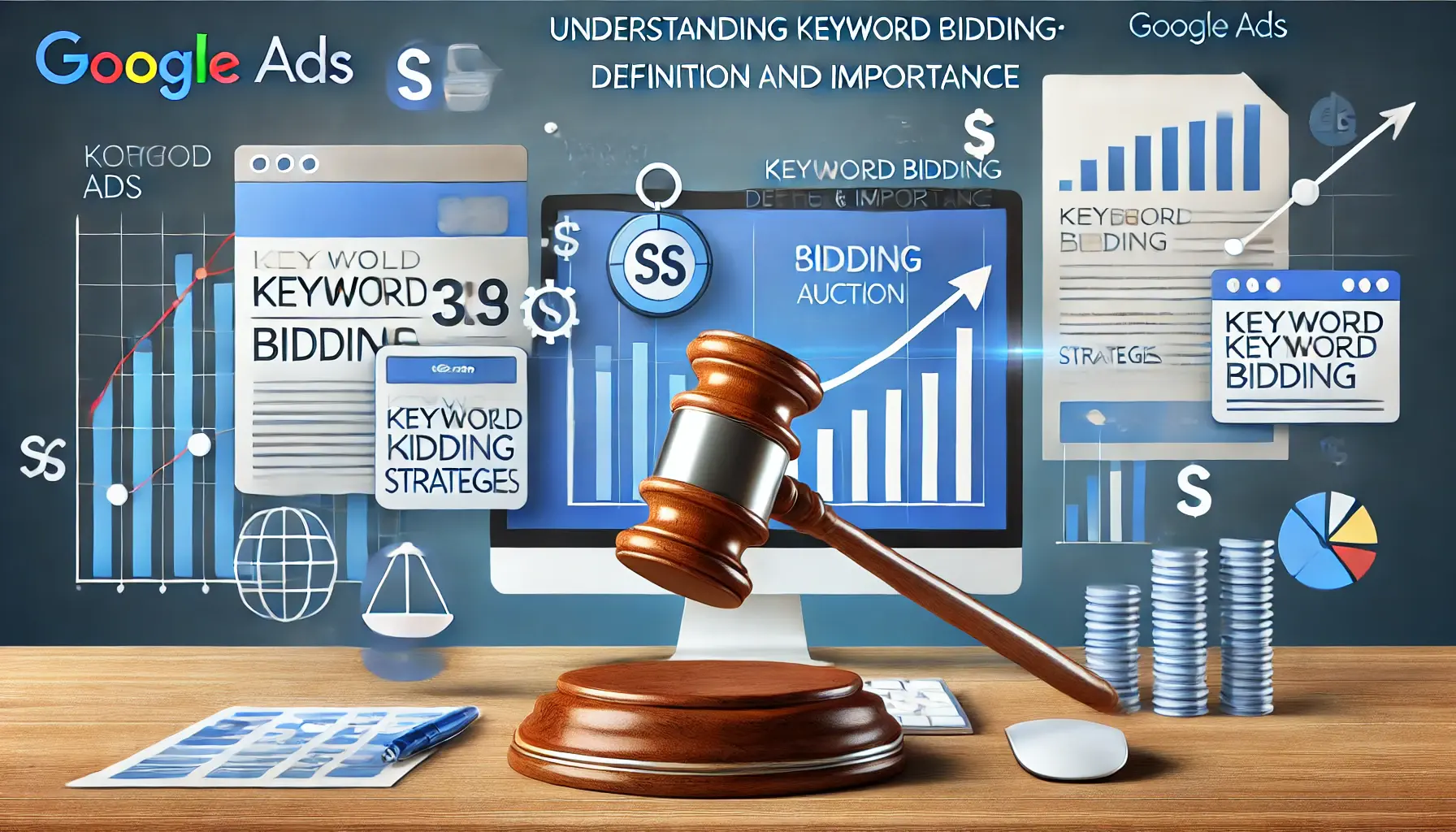
Digital marketing image representing the definition and importance of keyword bidding strategies in Google Ads.
Understanding Keyword Bidding: Definition and Importance
At its core, keyword bidding refers to the process of selecting and setting a maximum price you are willing to pay for each click on your ad (also known as cost-per-click or CPCCost-Per-Click, a bidding model where advertisers pay for each click on their ad.).
This is a very important bid, as this enables Google to determine where your ad is going to sit in the search results.
Ads that have higher bids, combined with better Quality Scores, tend to be right at the top of the SERPSearch Engine Results Page, the page displayed by search engines in response to a query., which can provide more exposure and click-through rates.
Otherwise put, if one is not strategic about the bids, one may either overspend on low-value clicks or, even worse, not capture high-value traffic.
By carefully selecting and managing your keyword bids, you’ll manage to drive more relevant traffic to your site while keeping costs in check.
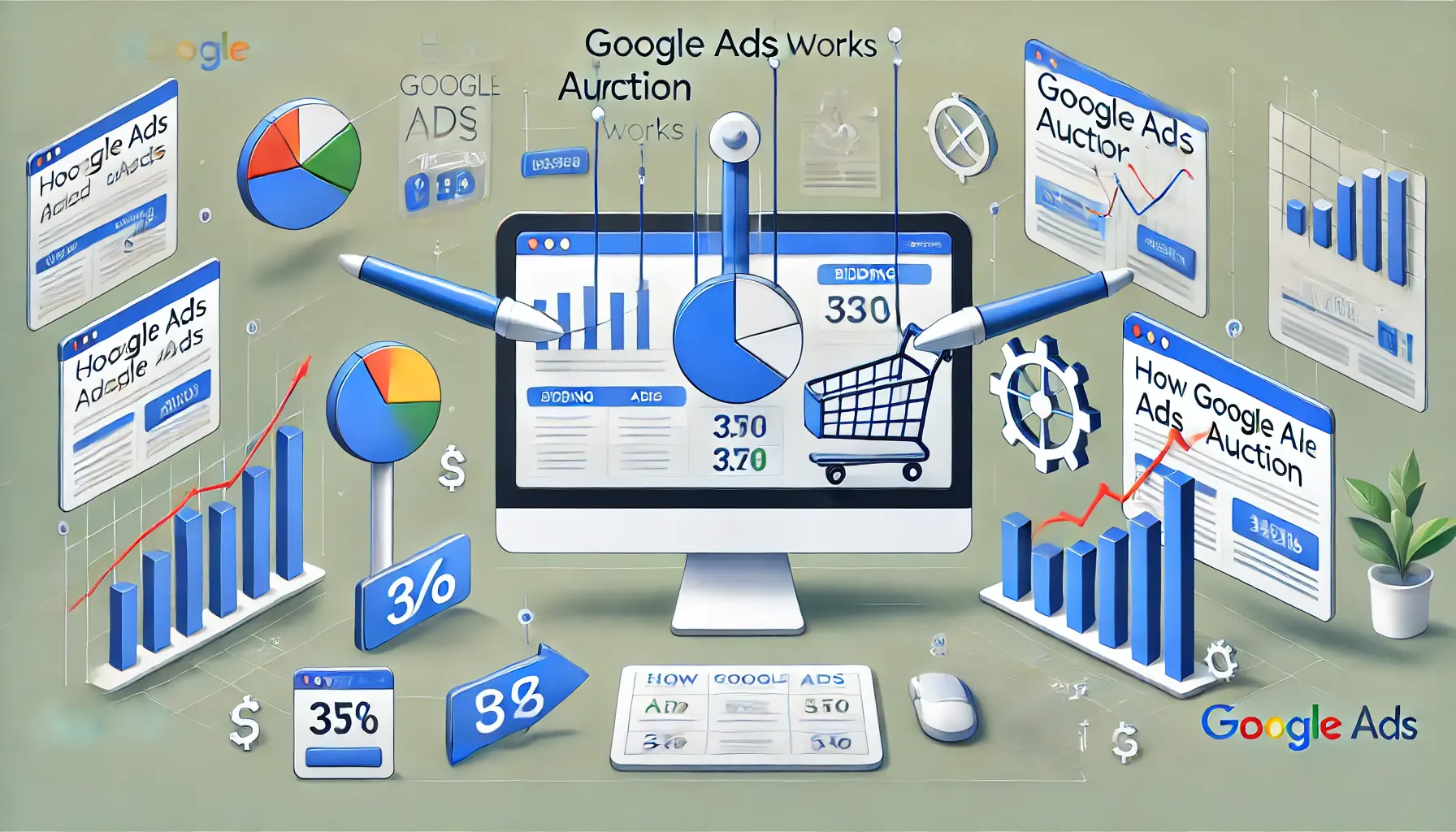
Illustration depicting the auction process in Google Ads, showing bidding dynamics and ad rankings.
How Google Ads Auction Works
The Google Ads auction is where all magic happens.
With each keyword search, an auction must occur to determine which ads will pop up and in what order.
Unlike any traditional auction, however, the highest bidder is not always the winner.
Instead, Google considers both the bid amount and the ad’s Quality Score—a function of relevance, expected CTRClick-Through Rate, the ratio of users who click on an ad to the number of total users who view the ad., and the quality of the landing page experience, among other factors—prior to auction.
- Bid amount: The maximum amount you are willing to pay for one click on your ad.
- Quality Score: Google’s rating that assesses an account’s relevance and quality regarding keywords and ad content.
- Ad Rank: A measure that results from combining the bid with the Quality Score; it determines the position of your ad on the SERP.
To perform well in the Google Ads auction, there needs to be a good balance between bid and Quality Score.
Even if your bid is lower than a competitor’s, a high Quality Score can give you an edge and result in better ad placement.
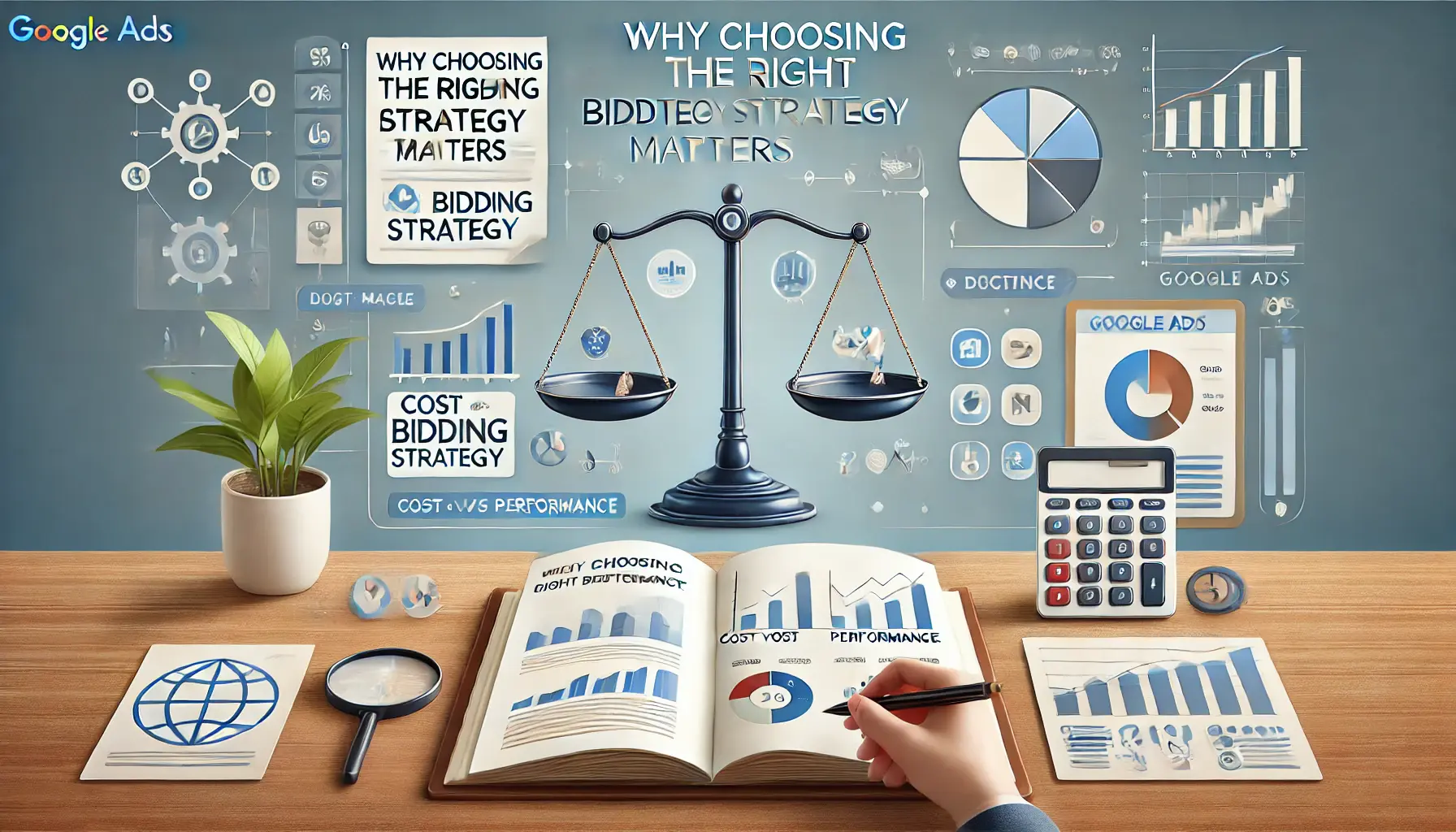
Illustration emphasizing the importance of selecting the right bidding strategy in Google Ads, showing the balance between cost and performance.
Why Choosing the Right Bidding Strategy Matters
Your keyword bidding strategy can make or break your campaign’s success.
Depending on your goals, whether it’s driving traffic, boosting conversions, or maximizing return on ad spend (ROASReturn on Ad Spend, a marketing metric that measures the revenue earned for every dollar spent on advertising.), the strategy you choose will determine how effectively you reach your objectives.
A click-maximizing strategy, for example, is best for generating traffic.
But in other cases, when the focus would fall on getting conversions for the target price, the target CPACost Per Acquisition, the cost associated with acquiring a customer through advertising. would be much better.
To get the most out of Google Ads keyword bidding, one needs to align the bidding strategy with one’s campaign goals in an ideal way.
Don’t just set and forget your bids; be constantly on the lookout, changing them when necessary to reach optimal performance.
Keyword bidding in Google Ads allows advertisers to determine their price for each click, with the bid amount and Quality Score determining ad placement.
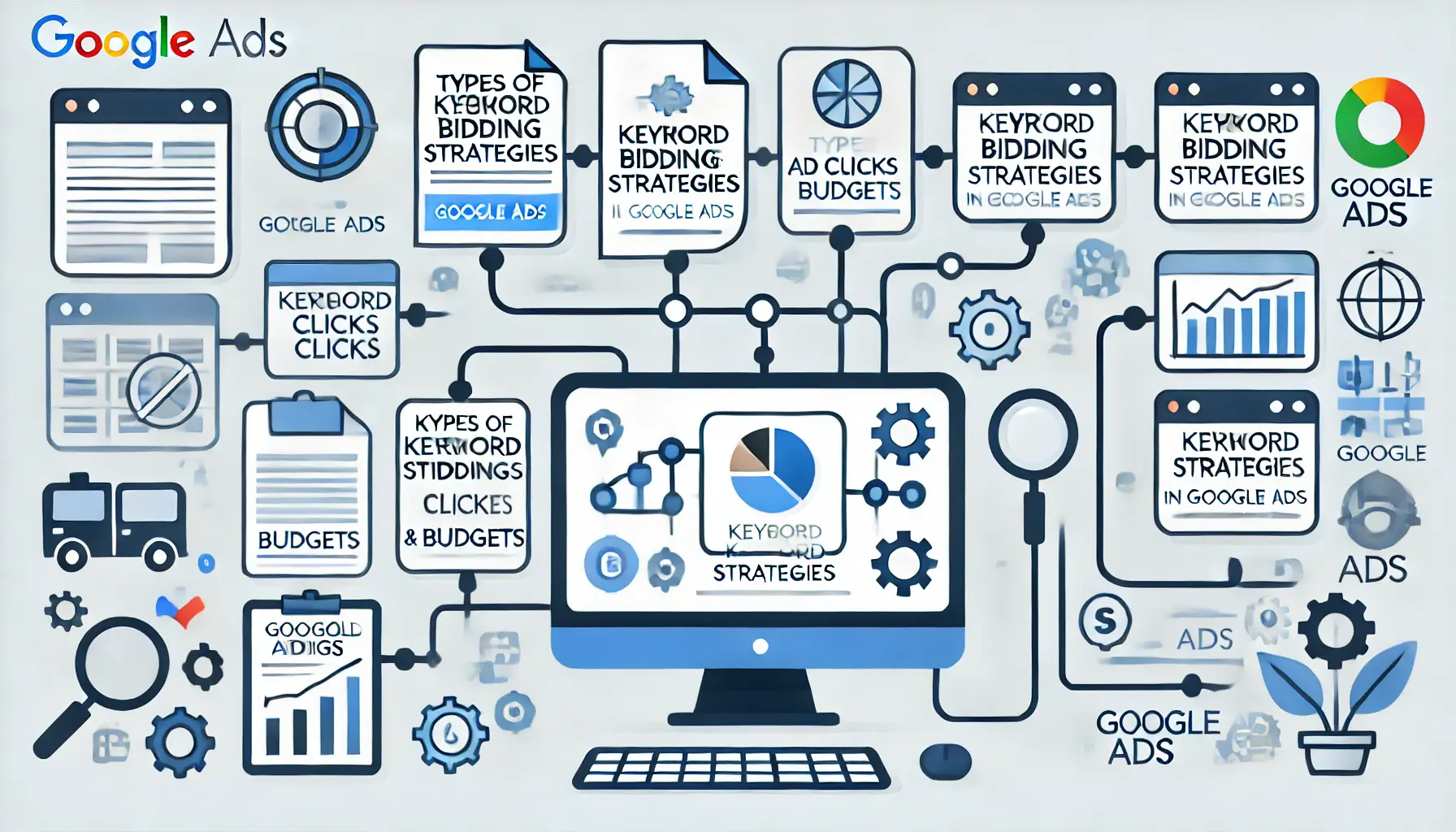
Illustration representing different types of keyword bidding strategies in Google Ads, with visuals showing multiple approaches to optimizing bids.
Types of Keyword Bidding Strategies in Google Ads
Keyword bidding is an integral part of any campaign setup in Google Ads, and choosing the right keyword bidding strategy can make all the difference between a successful campaign to generate traffic, drive conversions, or maximize your return on ad spend (ROAS).
Google offers a number of different bid strategies, and choosing the right one for your business goals is vital.
Understanding these nuances will provide you with greater control over the performance of your ads and enable you to make more strategic decisions regarding your keyword bidding.
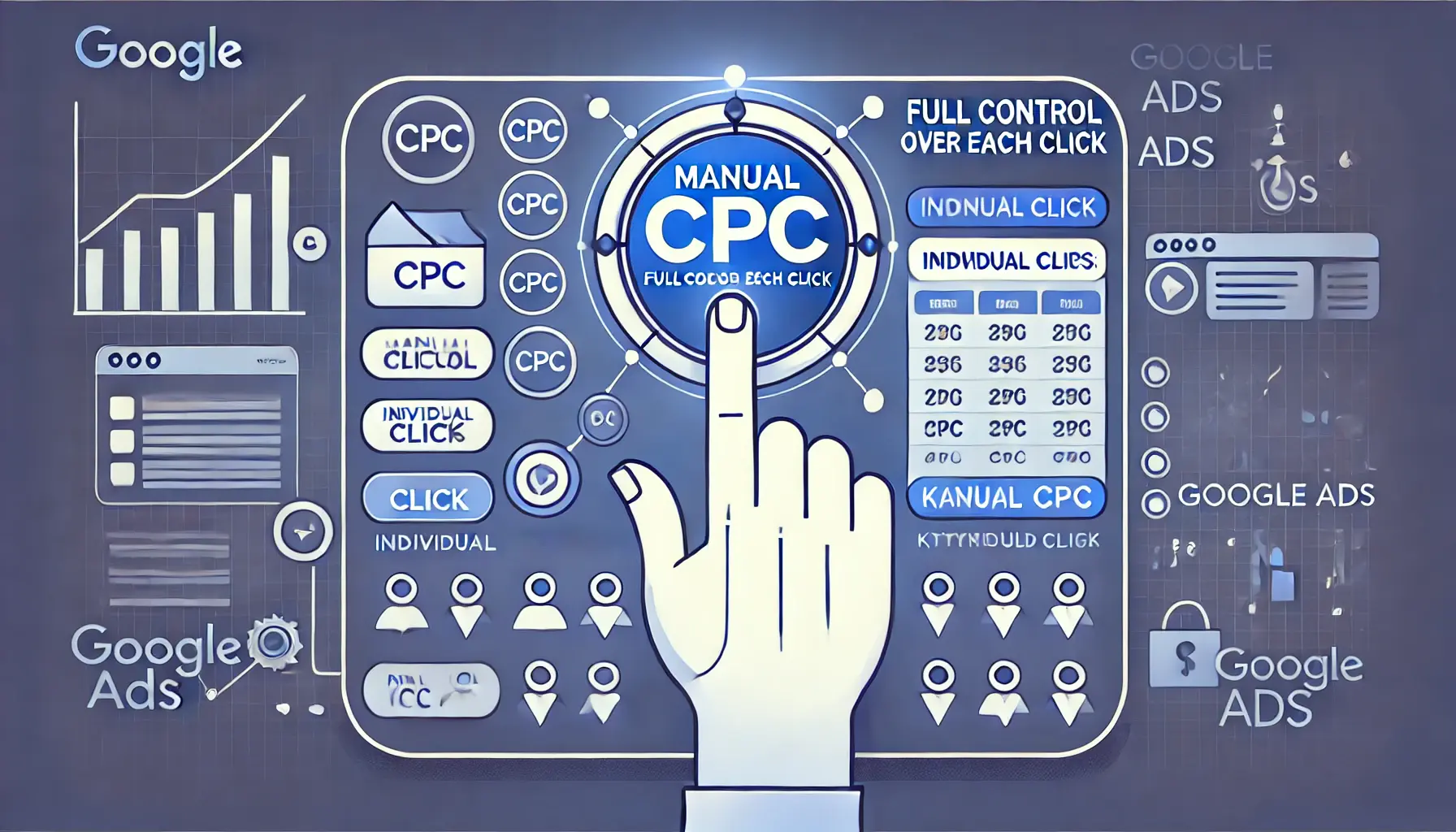
Illustration representing full control over each click in Manual CPC bidding strategy in Google Ads.
Manual CPC: Full Control over Each Click
Manual CPC is a strategy whereby a maximum amount is set by yourself as a bid for the ads.
This strategy gives you full control over your bids, allowing you to adjust them based on your budget and performance.
It’s best for advertisers who want to maintain complete control over their spending or optimize individual keyword bids on their own.
Of course, Manual CPC often requires ongoing management to ensure you don’t overspend on clicks that don’t convert.
While this method provides granular control, the downside is that large campaigns can be less effective as bid management becomes time-consuming.
However, for niche and targeted ads, it’s a reliable way to ensure you’re paying only what you want per click.
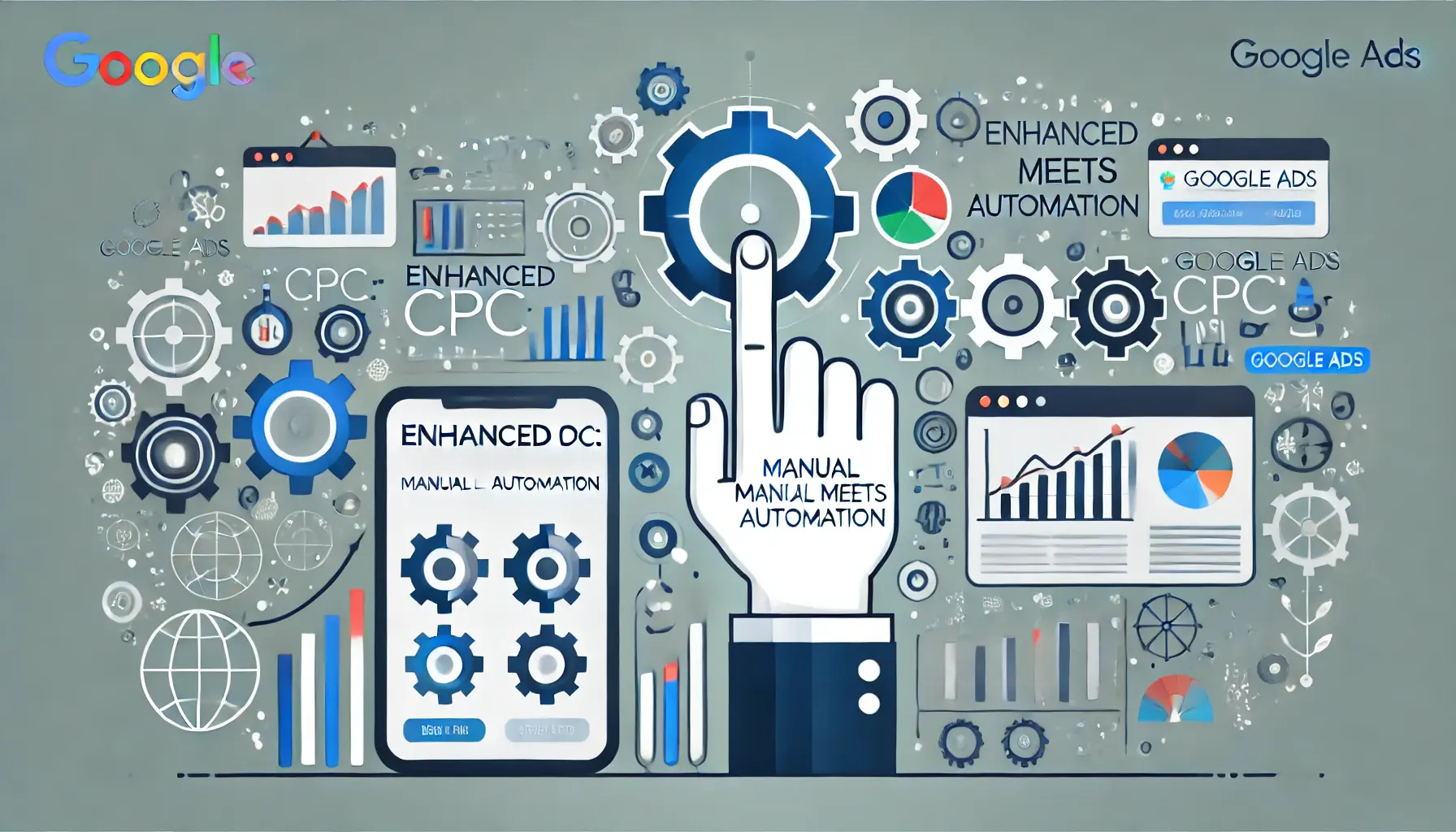
Illustration representing the fusion of manual control and automation in Enhanced CPC bidding strategy.
Enhanced CPC: Manual Meets Automation
Enhanced CPC (ECPC) combines the best of manual CPC with Google’s automated bidding system.
It automatically adjusts your bids based on the likelihood of conversion, allowing you to pay more for clicks that are more likely to result in a sale or a lead.
Google’s algorithms predict the potential value of each click in real time, providing an advantage through automation without losing full control.
Enhanced CPC is one of the easiest ways to get started with automation if you’re used to manual bidding.
It offers some flexibility while leveraging Google’s machine learning capabilities to enhance ad performance.

Illustration representing the strategy of maximizing clicks for traffic generation in Google Ads.
Maximize Clicks: Best for Traffic Generation
Maximize Clicks is a fully automated bidding strategy that focuses on obtaining the most clicks within your daily budget.
It is ideal for businesses seeking to drive more traffic to their website without worrying about manually setting bids.
Google automatically updates your bids in real time to get the most clicks possible within your budget.
This strategy works well for campaigns where the main goal is website traffic.
However, it doesn’t always guarantee high-quality leads or conversions, so it’s essential to monitor the quality of the traffic generated.
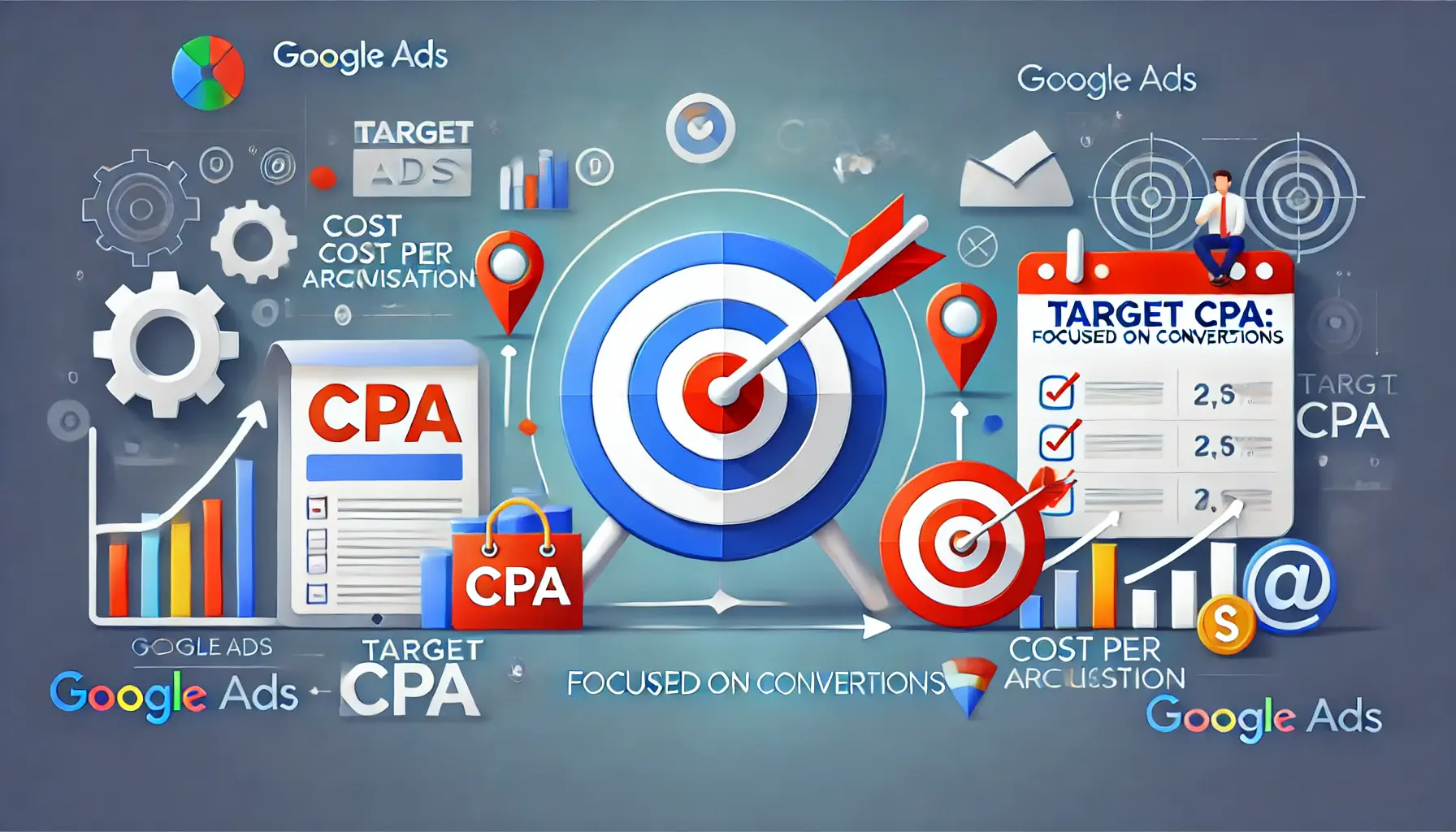
Illustration showing the concept of Target CPA, emphasizing conversions and cost efficiency in Google Ads.
Target CPA: Focused on Conversions
Target CPA (Cost Per Acquisition) is an automated bidding strategy designed to help advertisers get as many conversions as possible at or below a specified cost per acquisition.
With this strategy, you set a target CPA, and Google automatically adjusts your bids to achieve the desired cost per conversion.
Target CPA is an excellent option if your goal is to drive sales or leads within a specific budget.
However, it may take time for Google’s algorithms to optimize based on your target CPA, so patience is required for this strategy to perform effectively.
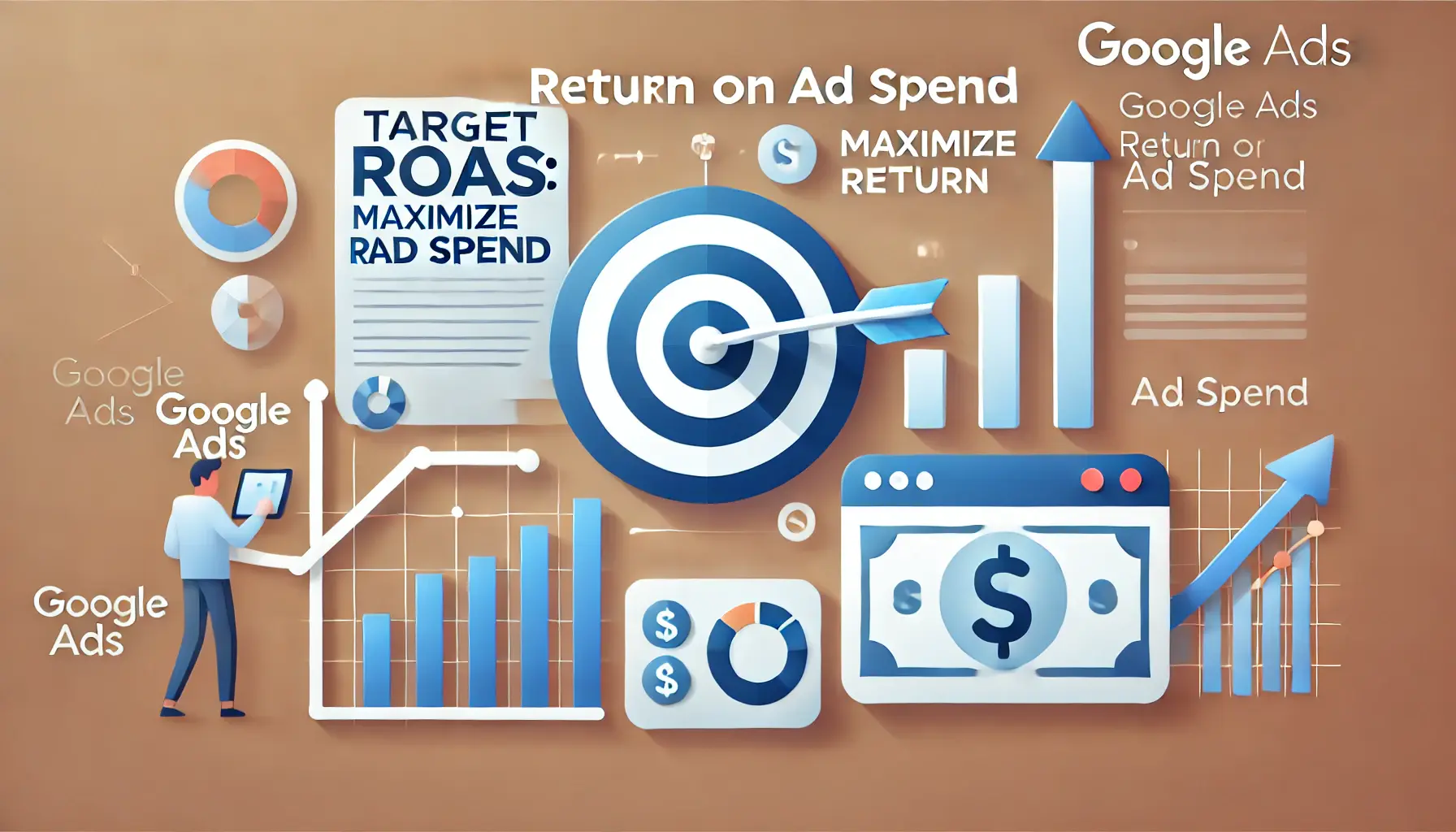
Illustration depicting the strategy of maximizing return on ad spend (ROAS) in Google Ads, showing revenue growth and increased returns.
Target ROAS: Maximize Return on Ad Spend
Target ROAS (Return on Ad Spend) is a bidding strategy that focuses on maximizing the revenue generated from your ad spend.
You set a target ROAS, and Google adjusts your bids to deliver the highest possible return based on your target.
This strategy is well-suited for businesses that have a clear understanding of their profit margins and want to maximize revenue while controlling costs.
Accurate conversion tracking is essential for Target ROAS to work effectively.
It is a perfect fit for e-commerce businesses looking to scale campaigns based on profit and revenue, rather than just traffic or leads.
Choosing the right keyword bidding strategy is critical to achieving your advertising objectives.
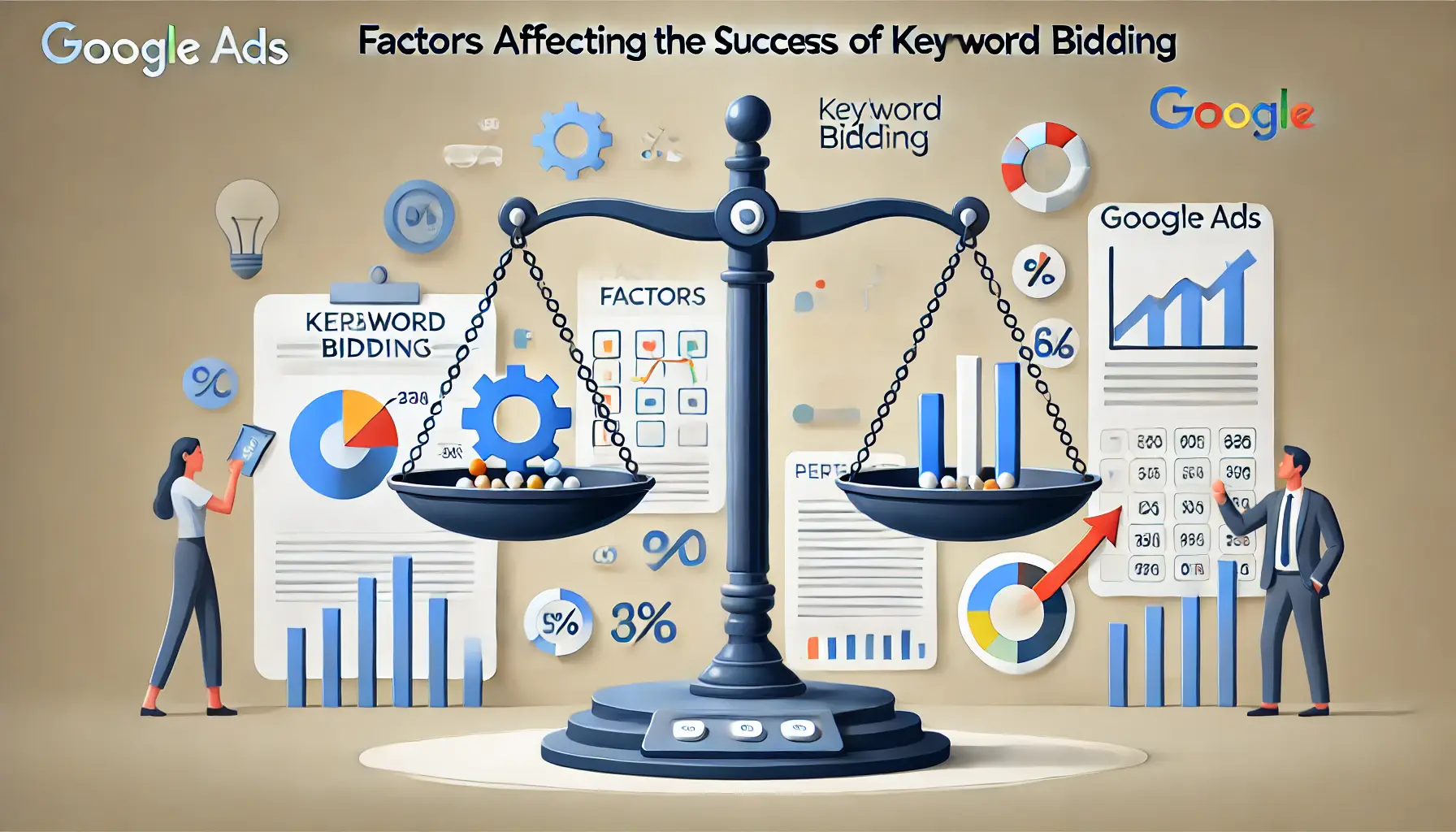
Illustration representing the key factors that impact the success of keyword bidding in Google Ads.
Factors Affecting the Success of Keyword Bidding
It is not straightforward being an excellent auctioneer for Google Ads.
It is essential to understand the different influences that impact your keyword bidding strategy.
Setting a correct bid is very important, but there are other fundamental elements that determine the efficiency of your ads and how economically you reach your marketing objectives.
By focusing on these factors, you can optimize your keyword bidding strategies and get the most out of your ad spend.

Illustration showing the importance of Quality Score in influencing bidding and ad rankings in Google Ads.
Quality Score: The Role in Bidding and Ad Ranking
The Quality Score is one of the most critical factors in determining the success of your keyword bidding efforts.
It’s a metric that Google uses to evaluate the relevance and quality of your ads, keywords, and landing pages.
A higher Quality Score can contribute to a lower cost-per-click (CPC) while giving you a better ad position, even if your actual bid is lower than the competition’s bid.
Multiple factors come into play in determining the Quality Score, including:
- Expected Click-Through Rate (CTR): Google predicts how likely your ads will be clicked when shown.
- Ad Relevance: How closely your ad relates to the user’s search intent.
- Landing Page Experience: The relevance and quality of the landing page users are directed to after clicking your ad.
Time and effort invested in improving your Quality Score can significantly reduce overall ad costs while increasing performance.
Therefore, this is a vital factor in successful keyword bidding.
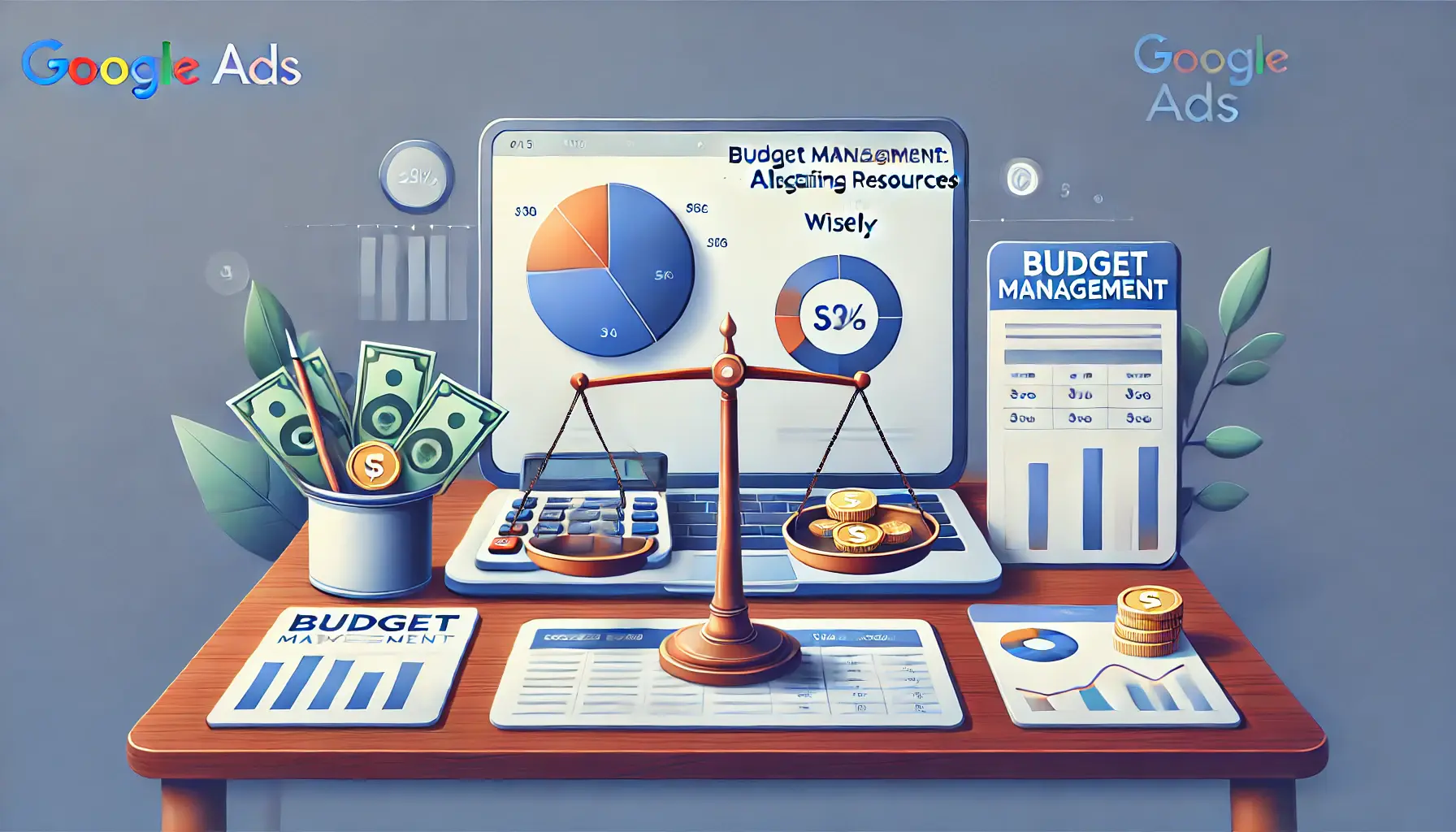
Illustration depicting the strategic allocation of resources in budget management for Google Ads campaigns.
Budget Management: Allocating Resources Wisely
By setting the appropriate budget for your campaigns, you ensure the best outcomes without overspending.
It’s essential to allocate resources based on what each campaign aims to achieve.
For instance, a conversion-focused campaign may require a higher budget than one aimed solely at driving traffic.
Key areas of budget management include:
- Daily Budgets: Set daily limits to control your spending across multiple campaigns.
- Bid Adjustments: Modify bids based on device, location, and time of day to ensure your ad appears when conversions are most likely.
- Budget Optimization: Regularly review performance and reallocate resources to campaigns with the highest ROI.
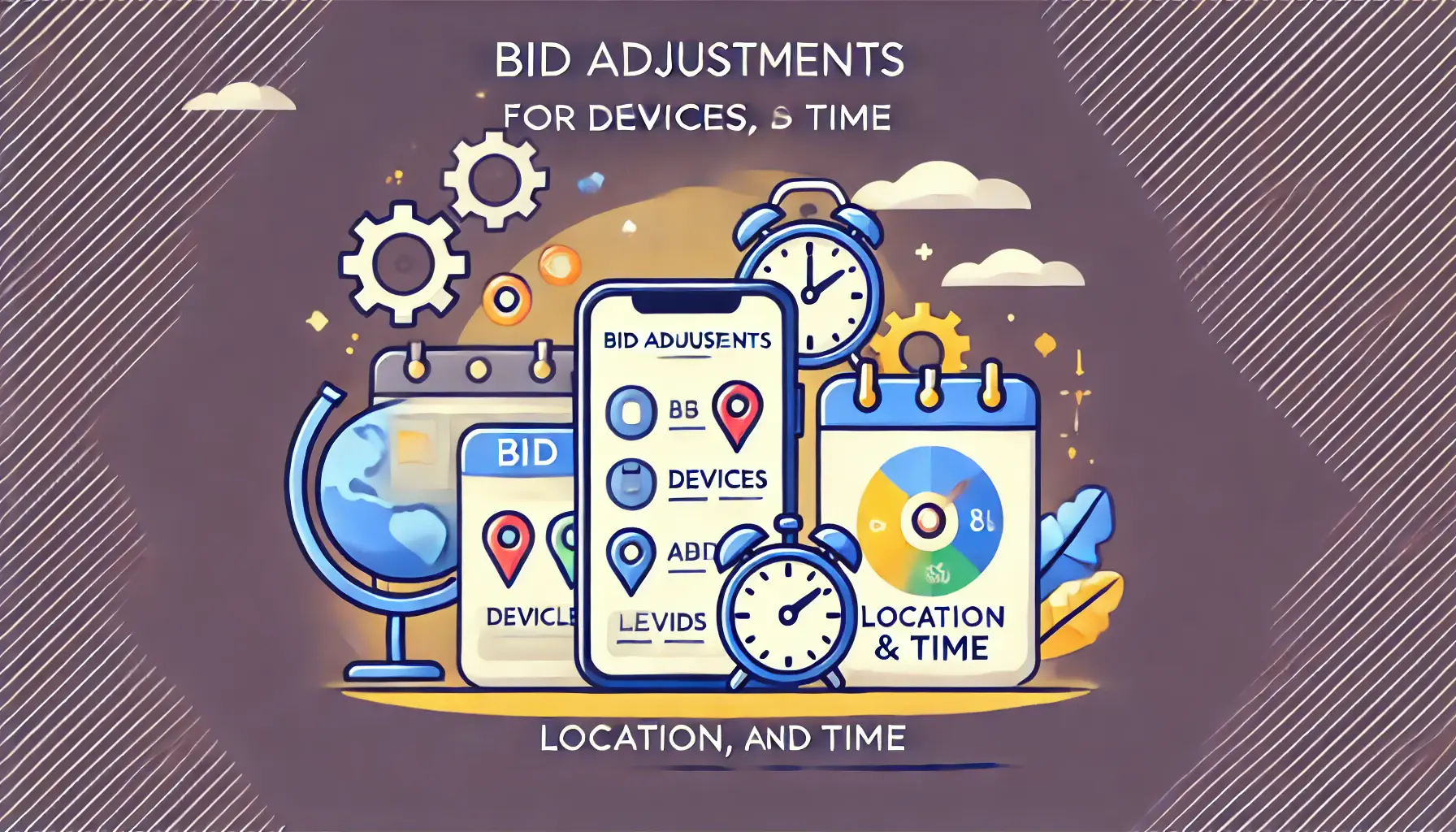
Illustration showing strategic bid adjustments for devices, location, and time in Google Ads campaigns.
Bid Adjustments for Devices, Location, and Time
Bid adjustments are an additional multiplier applied to your base bids, allowing you to optimize your ad spend based on conditions you define.
These adjustments can be positive or negative and can be made for:
- Devices: Adjust bids for mobile, desktop, or tablet devices based on performance.
- Locations: Focus on geographic areas with higher conversion rates by adjusting bids accordingly.
- Time of Day: Increase or decrease bids during times when your audience is more likely to engage with your ads.
These bid adjustments ensure your ads appear at the right time, in the right place, and on the right device, maximizing the effectiveness of your keyword bidding strategy.

Illustration depicting the importance of competitor analysis and keyword research in optimizing Google Ads campaigns.
Competitor Analysis and Keyword Research
Success in keyword bidding partly depends on understanding your competitors.
Competitor analysis helps you identify the keywords they target and how they position their ads.
Tools like Google Ads Auction Insights provide deep insights into your competitors’ bidding strategies, showing where your ad ranks compared to others in the same auction.
Additionally, thorough keyword research allows you to discover new opportunities and refine your bidding strategy.
Identify lucrative keywords that are underutilized, or find long-tail keywords that drive valuable traffic at a lower cost.
Continuous competitor analysis and keyword research enable you to stay ahead and make data-driven decisions that enhance your keyword bidding strategy.

Illustration showing advanced strategies for optimizing keyword bids in Google Ads campaigns, including analytics and automation.
Advanced Keyword Bid Optimization Techniques
As you develop a keyword bidding strategy, consider the following advanced techniques to gain a competitive advantage and improve campaign efficiency.
Automation, A/B testing, and Google Ads tools can significantly enhance your bidding processes and ad performance.
These advanced methods ensure you get the best out of your ad spend while staying ahead of competitors in the constantly evolving digital landscape.

Illustration depicting how automated bidding tools enhance efficiency in Google Ads campaigns by optimizing bids.
Driving Efficiencies by Deploying Automated Bidding Tools
Automation within Google Ads has become one of the strongest options for optimizing keyword bids while saving time.
Automated bidding strategies, including Maximize Conversions, Target CPA, and Target ROAS, use Google’s machine learning to adjust bids instantly based on performance data and the probability of achieving your campaign goals.
These tools help optimize your bids efficiently, particularly for large campaigns that would take too much time to adjust manually.
However, it’s important to monitor automated strategies closely to ensure they remain aligned with your goals and perform as expected.

Illustration showing how A/B testing can be used to compare different keyword bids for performance insights in Google Ads.
A/B Testing Keyword Bids for Performance Insights
You can run experiments on different bid amounts for the same keywords to gather valuable data on which bid levels drive the most clicks, conversions, or maximize your ROI.
Here’s how to run a proper A/B test for keyword bids:
- Choose a segment of top-performing keywords that generate consistent traffic.
- Set two different bid levels for each keyword, keeping all other variables constant, such as ad copy and targeting.
- Run the test long enough to capture meaningful data and analyze which bid performs better according to your goals.
A/B testing allows you to make granular adjustments to keyword bids and make data-driven decisions for better campaign efficiency.

Illustration showing how bid strategy experiments help find the optimal bidding approach in Google Ads campaigns.
Bid Strategy Experiments: Finding What Works
Google Ads allows you to run bid strategy experiments within the platform.
These experiments enable you to test multiple bidding strategies side by side, such as comparing Target CPA against Manual CPC, to determine which strategy best suits your campaign objectives.
To run a bid strategy experiment, set up an experiment group and a control group within your campaign.
Google automatically segments your traffic between these groups, allowing you to compare performance metrics such as click-through rates, conversions, and cost-per-click for the different strategies.
Bid strategy experiments help ensure that you are using the most effective keyword bidding approach, whether focused on performance or cost efficiency.

Illustration showing how AI and machine learning are used to create smarter bidding strategies in Google Ads.
Smarter Bidding with AI and Machine Learning
AI and machine learning are transforming how advertisers approach keyword bidding.
Machine learning algorithms can analyze large volumes of data and estimate which bid is most likely to result in conversions, while adjusting bids in real time.
Enhanced CPC and Maximize Conversions are examples of AI-driven, automated bidding strategies.
Applying AI and machine learning to keyword bidding offers several advantages:
- Predictive bidding based on historical data and user behavior.
- Real-time bid adjustments based on time of day, device, and user demographics.
- Optimization of long-tail keywords that may not perform as well with manual bidding.
As AI and machine learning continue to advance, these technologies will play an increasingly important role in helping advertisers optimize their keyword bids and drive superior results.

Illustration showing common mistakes to avoid when managing keyword bids in Google Ads campaigns.
Common Mistakes to Avoid in Keyword Bidding
Even with a well-developed keyword bidding strategy, mistakes can arise and hinder the effectiveness of your campaigns.
These common pitfalls can result in missed opportunities, wasted ad spend, and lower overall performance.
By being aware of these mistakes, you can ensure that your bids are optimized for success and that you get the best return on your investment.
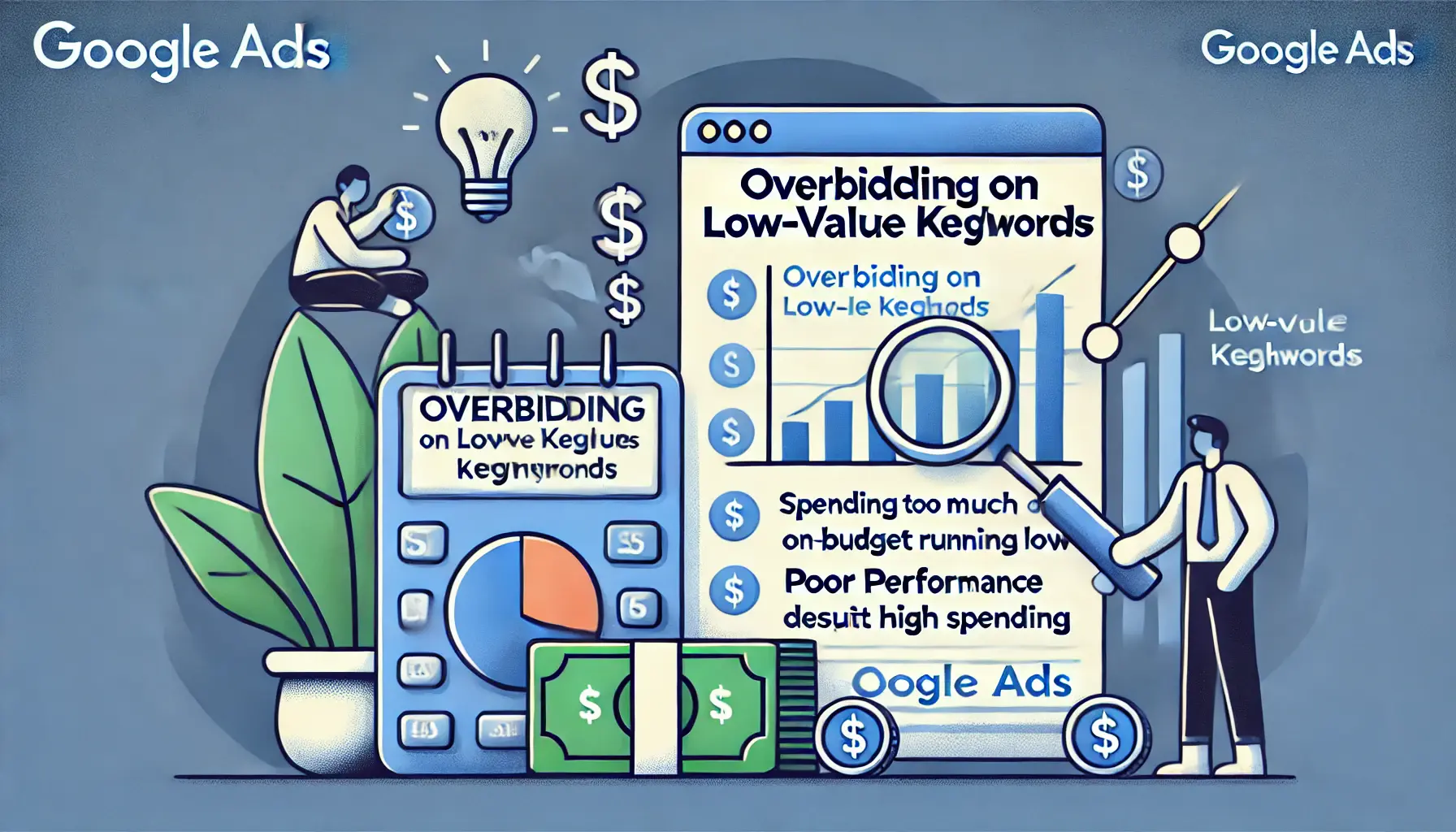
Illustration depicting the mistake of overbidding on low-value keywords in Google Ads campaigns.
Overbidding on Low-Value Keywords
Overbidding on low-value keywords may result in overpaying for traffic that doesn’t deliver results.
Instead, focus on identifying high-intent keywords that are more likely to lead to conversions.
A keyword research tool can help you prioritize keywords based on relevance and potential ROI, ensuring that your bids reflect the actual value of each keyword.

Illustration showing the importance of managing negative keywords in Google Ads campaigns to avoid wasted impressions and irrelevant traffic.
Ignoring Negative Keywords
Failing to catch and use negative keywords can lead to your ads being displayed to irrelevant audiences, wasting impressions and ad spend.
To prevent this, always build a strong negative keyword list to filter out irrelevant traffic.
Continuously update this list through search term reports to ensure that your ads target a relevant audience.
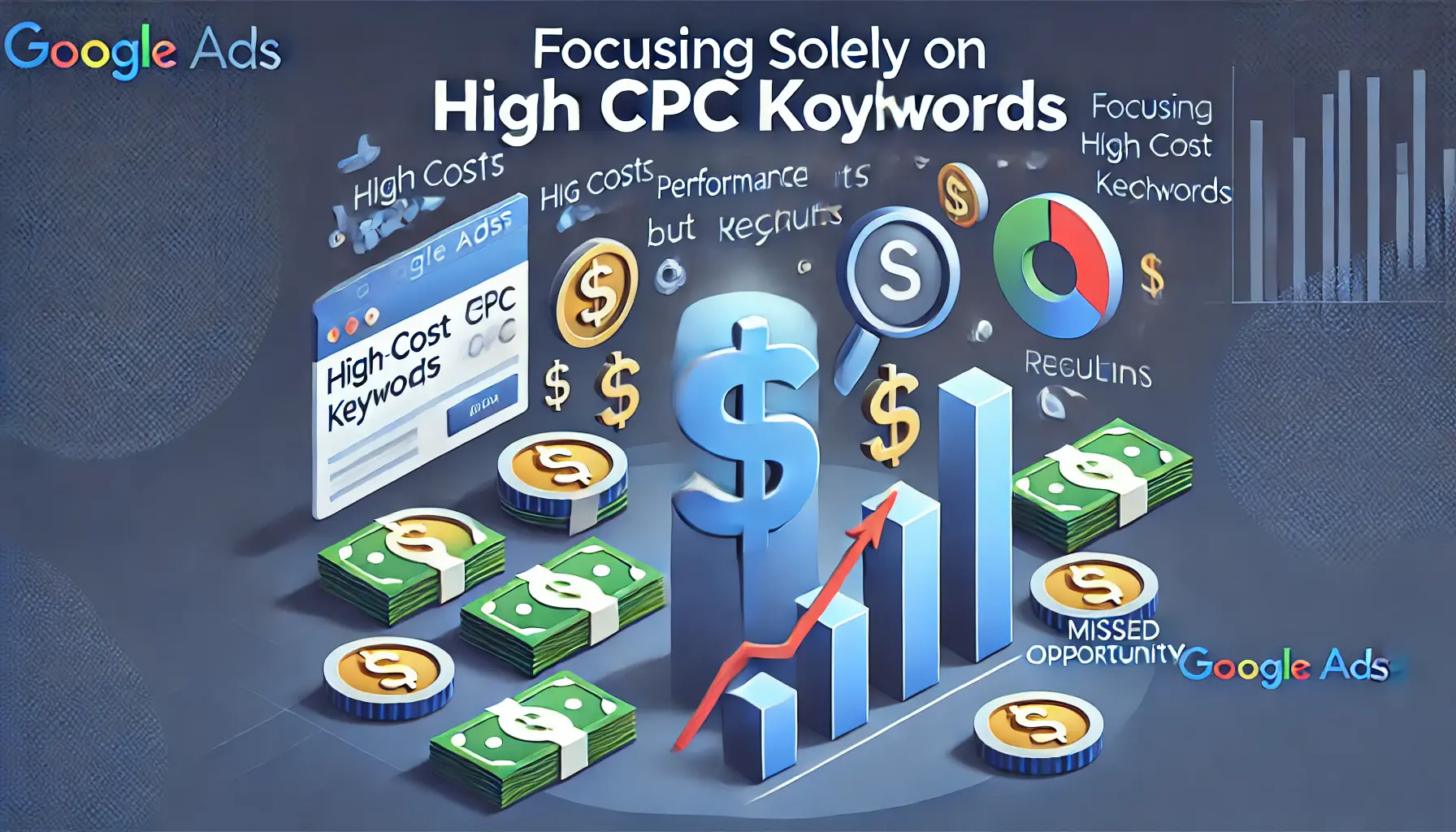
Illustration depicting the risks of focusing exclusively on high CPC keywords in Google Ads campaigns.
Focusing Solely on High CPC Keywords
High-CPC keywords might drive traffic, but they can also quickly drain your budget without delivering proportional results.
These keywords are often highly competitive and may not be the best choice for every campaign.
To avoid this mistake, consider targeting long-tail keywords, which tend to have lower competition, lower CPCs, and can drive more qualified traffic.
Although they may generate less traffic than high-CPC keywords, they often provide a better return on investment (ROI).
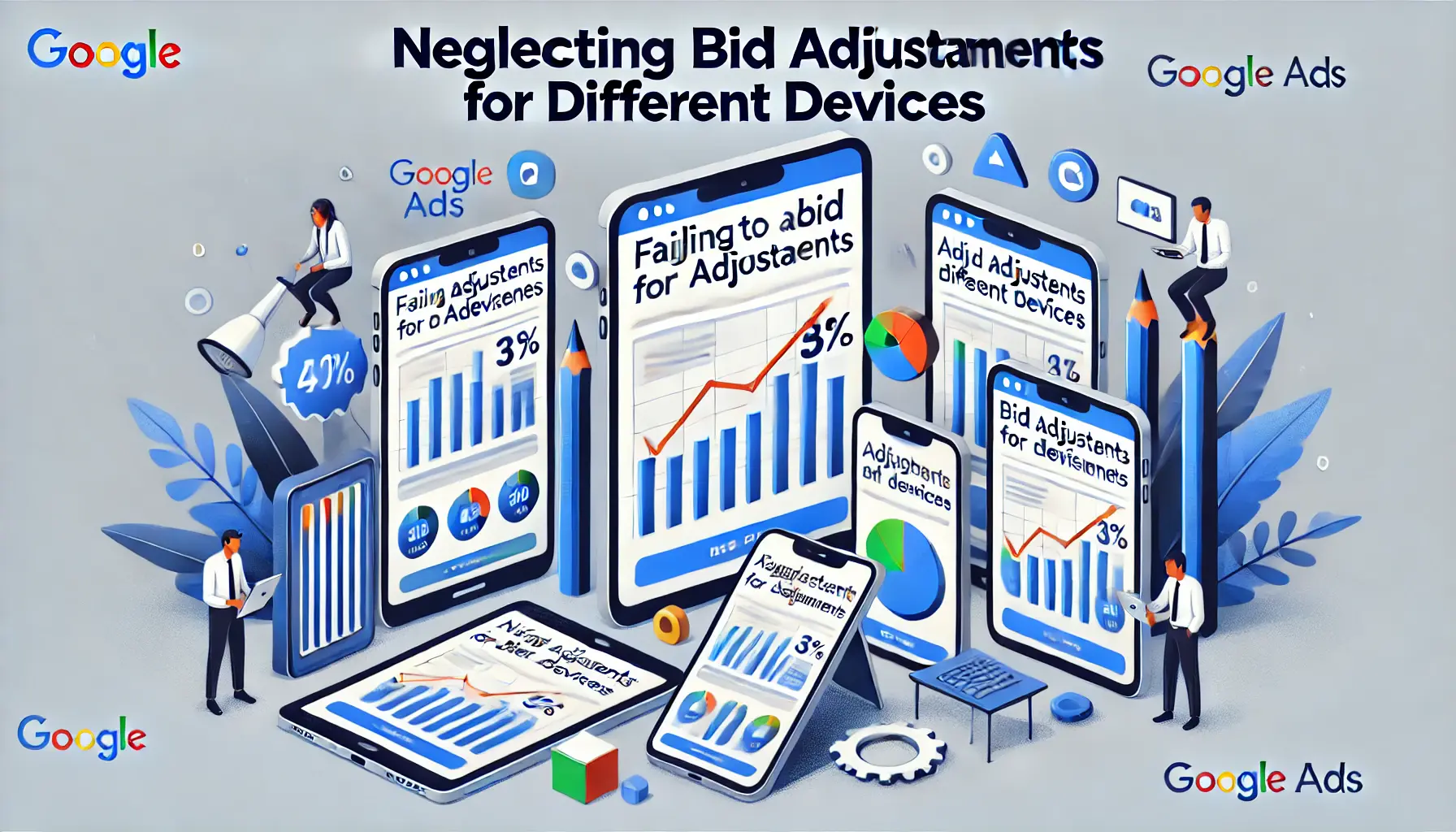
Illustration showing the risks of neglecting bid adjustments for different devices in Google Ads campaigns.
Neglecting Bid Adjustments for Different Devices
Another common oversight in keyword bidding is neglecting to adjust bids for different devices.
User behavior varies significantly depending on whether someone is searching on a desktop, tablet, or mobile device.
Failing to optimize your bids for device type can result in missed opportunities or wasted ad spend.
Use performance data to determine how different devices impact your campaign performance.
If mobile users convert better, increase your bids for mobile searches.
Similarly, if desktop users are more valuable, set higher bids for desktop traffic.

Illustration showing the risks of setting bids and forgetting to optimize them in Google Ads campaigns.
Set and Forget Bids
Many advertisers make the mistake of setting bids and forgetting them, assuming that the initial bid will remain effective.
However, markets change, competition evolves, and keyword performance fluctuates over time.
Failing to regularly reassess and adjust bids can lead to underperformance or overspending.
Avoid this mistake by continuously monitoring your campaigns and adjusting bids based on performance data.
Regularly optimize your keyword bidding strategy to ensure it aligns with your marketing objectives and current market conditions.
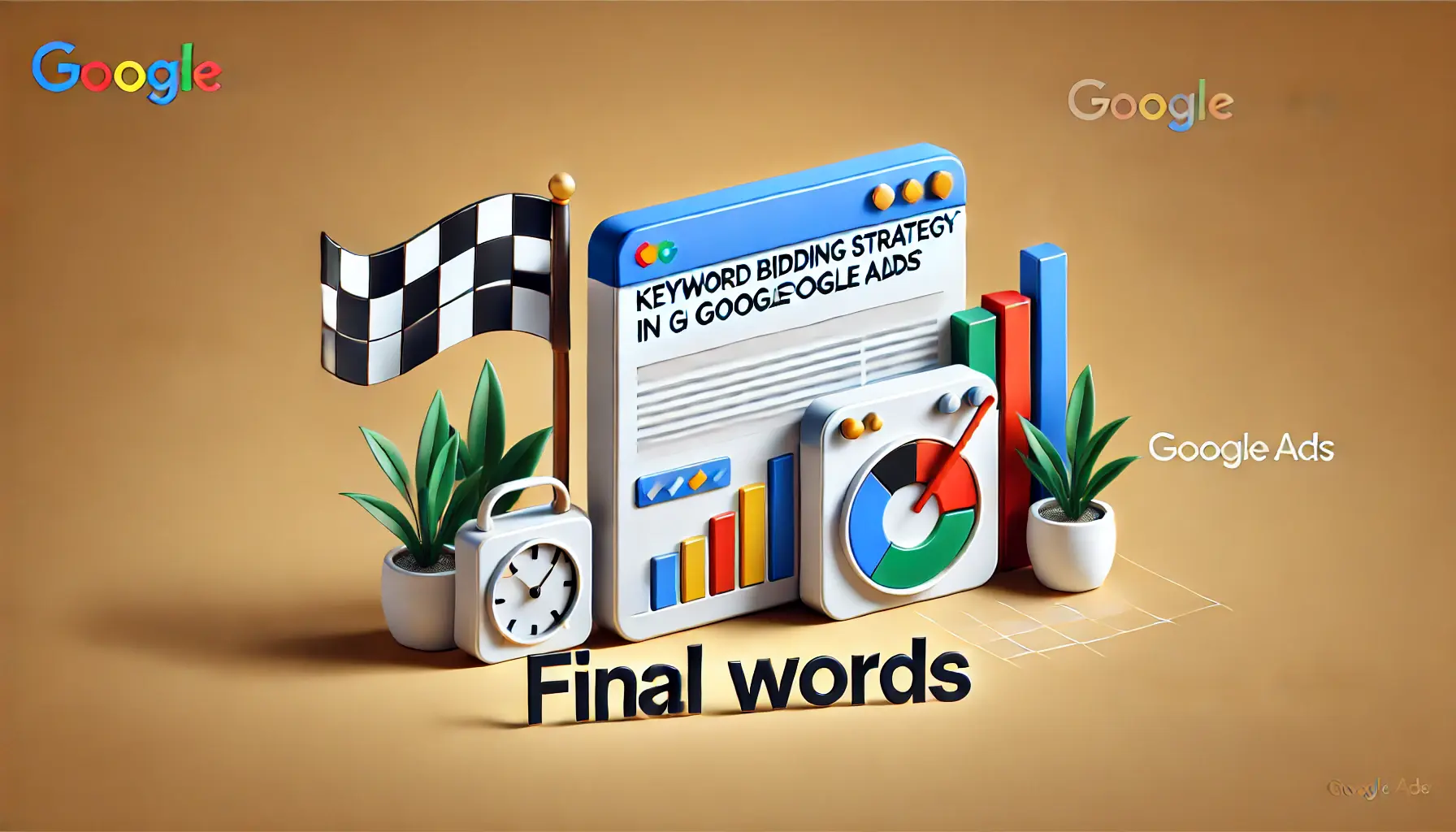
Illustration symbolizing the final thoughts and conclusions on keyword bidding strategies in Google Ads campaigns.
Keyword Bidding Strategy in Google Ads: Final Words
Optimizing keyword bidding strategies in Google Ads is instrumental for any business looking to optimize its ad spend for maximum ROI.
This article delved into various approaches to mastering keyword bidding, from understanding the basics to employing advanced techniques that fine-tune your campaigns.
By continuously optimizing your bids and staying proactive, you can ensure better ad performance and improved results.

Illustration highlighting the key takeaways for successful keyword bidding strategies in Google Ads.
Key Takeaways for Effective Keyword Bidding
To summarize the main points covered, here are the key takeaways to consider when developing your keyword bidding strategy:
- Focus on high-intent keywords that align with your campaign goals and are more likely to convert.
- Leverage automated bidding tools and machine learning to enhance bid efficiency and save time, especially for large campaigns.
- Run A/B tests and bid strategy experiments to find the most effective bid levels and strategies for your keywords.
- Don’t overlook negative keywords – continuously update your negative keyword list to filter out irrelevant traffic.
- Use bid adjustments for different devices, locations, and times to ensure your ads reach the right audience at the right time.
- Regularly reassess and adjust your bids to adapt to changing market conditions and keyword performance trends.

Illustration showing the importance of continuous optimization for achieving long-term success in Google Ads campaigns.
Continuous Optimization: The Key to Long-Term Success
The success of any keyword bidding strategy lies in continuous optimization.
Google Ads is dynamic; keyword performance, market trends, and competitor strategies change frequently.
What works today may not work tomorrow.
By constantly monitoring your campaigns, refining your bids, and staying updated with best practices, you can consistently enhance your performance and stay ahead of the competition.
Here’s why ongoing optimization is important:
- Adaptability: Markets, competitors, and consumer behavior change often, and you must adjust your bids accordingly.
- Efficiency: Regular optimization ensures that you are not overpaying for low-performing keywords or missing opportunities to maximize high-performing ones.
- Cost Management: Continuous bid adjustments help manage your budget efficiently to ensure a better return on investment.
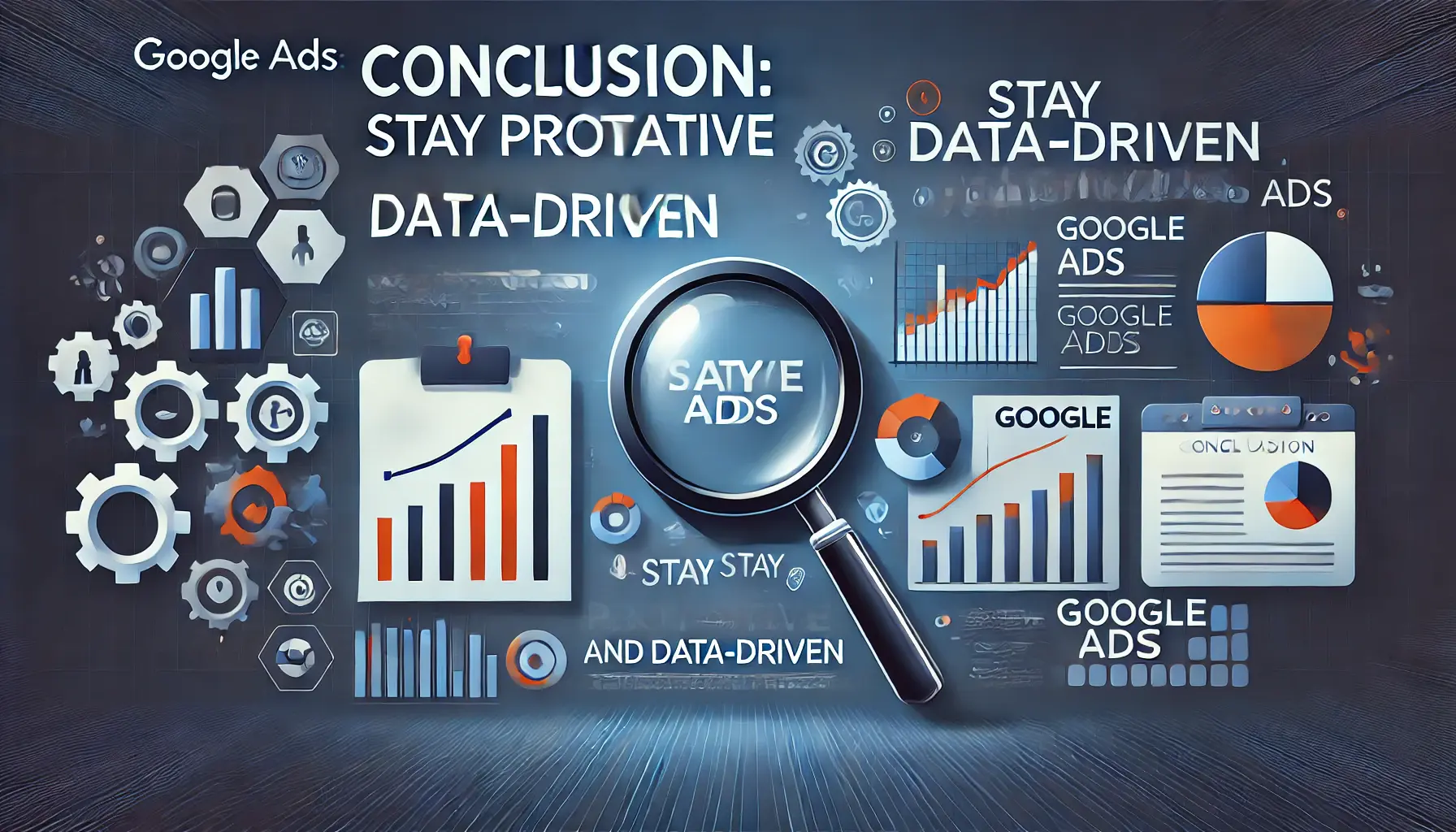
Illustration emphasizing the importance of staying proactive and data-driven in Google Ads campaigns.
Conclusion: Stay Proactive and Data-Driven
Success with keyword bidding in Google Ads is driven by a proactive, data-driven approach.
This article has outlined the strategies and techniques needed to develop a strong keyword bidding strategy that ensures effective ad spend, drives meaningful results, and positions your business for growth.
Keep in mind that keyword bidding operates in a cycle of testing, learning, and optimizing.
Stay hands-on with your campaigns, make decisions guided by data, and be ready to adjust your bids whenever new opportunities arise.
If executed properly, this approach sets the path for long-term success in the competitive world of Google Ads.

Illustration depicting the frequently asked questions (FAQs) section about keyword bidding strategies in Google Ads.
Your campaigns can be managed by an agency specialized in Google Ads, check out our service page.
Google Ads Keyword Bidding Strategy: Frequently Asked Questions
The following are some of the most frequently asked questions regarding keyword bidding strategy in Google Ads, with their respective answers to clarify common concerns among individuals.
In Google Ads, keyword bidding refers to the price that an advertiser sets as the maximum they’re willing to pay for every click on their ad.
This determines the ad’s position and whether the ad shows up or not.
A higher bid improves the chances of better ad placement, but relevance and user experience also play a key role.
High-intent keywords are search terms used by potential customers who are more likely to convert.
These keywords often indicate specific intent to purchase or take action related to your product or service.
Negative keywords filter out irrelevant search queries, preventing your ad from being shown to users unlikely to convert.
This improves ad efficiency and ensures that your ad budget is spent wisely.
Long-tail keywords are less competitive and have a lower cost-per-click, making them a more economical way to drive qualified traffic.
They typically provide better ROI compared to more expensive and high-competition keywords.
A/B testing helps identify the most effective bid levels and keyword bidding strategies by testing different variations.
It provides data-driven insights to optimize campaigns and improve ad performance.
AI and machine learning automate keyword bidding adjustments in real time.
These technologies improve ad performance by predicting which bids are more likely to result in conversions.
Bid adjustments allow advertisers to modify bids based on device type, location, and time of day, ensuring that ads are presented to the right audience at the right time.
